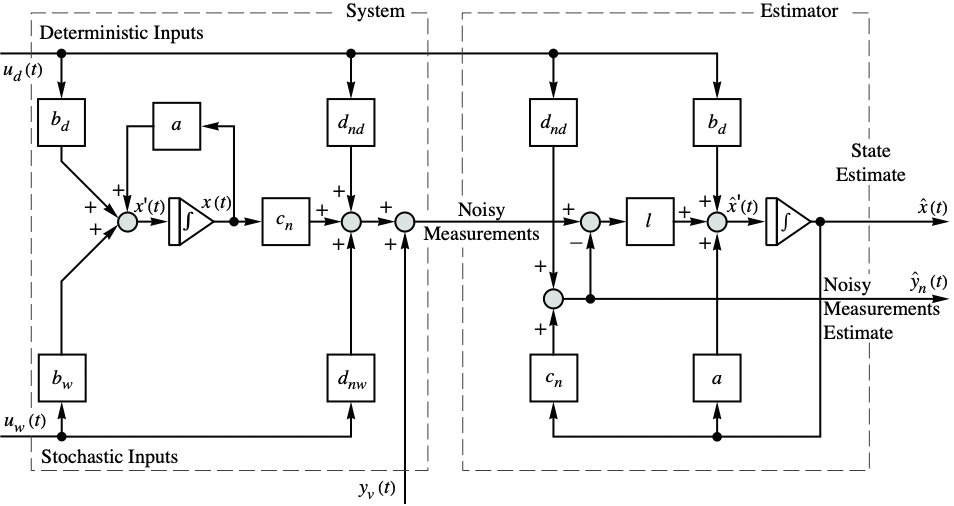KalmanEstimator
KalmanEstimator[ssm,{w,v}]
constructs the Kalman estimator for the StateSpaceModel ssm with process and measurement noise covariance matrices w and v.
KalmanEstimator[ssm,{w,v,h}]
includes the cross-covariance matrix h.
KalmanEstimator[{ssm,sensors},{…}]
specifies sensors as the noisy measurements of ssm.
KalmanEstimator[{ssm,sensors,dinputs},{…}]
specifies dinputs as the deterministic inputs of ssm.
Details and Options




- The standard state-space model ssm can be given as StateSpaceModel[{a,b,c,d}], where a, b, c, and d represent the state, input, output, and transmission matrices in either a continuous-time or a discrete-time system:
-

continuous-time system 
discrete-time system - The descriptor state-space model ssm can be given as StateSpaceModel[{a,b,c,d,e}] in either continuous time or discrete time:
-

continuous-time system 
discrete-time system - The inputs
 can include the process noise
can include the process noise  as well as deterministic inputs
as well as deterministic inputs  .
. - The argument dinputs is a list of integers specifying the positions of
 in
in  .
. - The outputs
 consist of the noisy measurements
consist of the noisy measurements  as well as other outputs.
as well as other outputs. - The argument sensors is a list of integers specifying the positions of
 in
in  .
. - The arguments sensors and dinputs can also accept values All and None.
- KalmanEstimator[ssm,{…}] is equivalent to KalmanEstimator[{ssm,All,None},{…}].
- The noisy measurements are modeled as
 , where
, where  and
and  are the submatrices of
are the submatrices of  and
and  associated with
associated with  , and
, and  is the noise.
is the noise. - The process and measurement noises are assumed to be white and Gaussian:
-
 ,
, 
process noise  ,
, 
measurement noise - The cross-covariance between the process and measurement noises is given by
 .
. - By default, the cross-covariance matrix
 is assumed to be a zero matrix.
is assumed to be a zero matrix. - KalmanEstimator supports a Method option. The following explicit settings can be given:
-
"CurrentEstimator" constructs the current estimator "PredictionEstimator" constructs the prediction estimator - The current estimate is based on measurements up to the current instant.
- The prediction estimate is based on measurements up to the previous instant.
- For continuous-time systems, the current and prediction estimators are the same, and the estimator dynamics are given by
 .
. - The optimal gain for continuous-time systems is computed as
![l=x_r.c_n.TemplateBox[{r}, Inverse] l=x_r.c_n.TemplateBox[{r}, Inverse]](Files/KalmanEstimator.en/28.png) , where
, where  solves the continuous algebraic Riccati equation
solves the continuous algebraic Riccati equation ![a.x_r+x_r.a-x_r.c_n.TemplateBox[{r}, Inverse].c_n.x_r+b_w.q.b_w=0 a.x_r+x_r.a-x_r.c_n.TemplateBox[{r}, Inverse].c_n.x_r+b_w.q.b_w=0](Files/KalmanEstimator.en/30.png) .
. - Block diagram for the continuous-time system with estimator:
- The matrices with subscripts
 ,
,  , and
, and  are submatrices associated with the deterministic inputs, stochastic inputs, and noisy measurements, respectively.
are submatrices associated with the deterministic inputs, stochastic inputs, and noisy measurements, respectively. - For discrete-time systems, the prediction estimator dynamics are given by
 . The block diagram of the discrete-time system with prediction estimator is the same as the one above.
. The block diagram of the discrete-time system with prediction estimator is the same as the one above. - The estimator dynamics of a current estimator for a discrete-time system are
 , and the current state estimate
, and the current state estimate  is obtained from the current measurement
is obtained from the current measurement  as
as  .
. - The optimal gain of the current estimator for a discrete-time system is computed as
![l_c=(x_r.c_n+b_w.h).TemplateBox[{{(, {{{c, _, n}, ., {x, _, r}, ., {{c, _, n}, }}, +, {{c, _, n}, ., {b, _, w}, ., h}, +, {{h, }, ., {{b, _, w}, }, ., {{c, _, n}, }}, +, v}, )}}, Inverse] l_c=(x_r.c_n+b_w.h).TemplateBox[{{(, {{{c, _, n}, ., {x, _, r}, ., {{c, _, n}, }}, +, {{c, _, n}, ., {b, _, w}, ., h}, +, {{h, }, ., {{b, _, w}, }, ., {{c, _, n}, }}, +, v}, )}}, Inverse]](Files/KalmanEstimator.en/40.png) , where
, where  solves the discrete algebraic Riccati equation
solves the discrete algebraic Riccati equation  .
. - The optimal gain
 of the prediction estimator for a discrete-time system is computed as
of the prediction estimator for a discrete-time system is computed as  .
. - Block diagram for the discrete-time system with current estimator:
- The inputs to the Kalman estimator model are the deterministic inputs
 and the noisy measurements
and the noisy measurements  .
. - The outputs of the Kalman estimator model consist of the estimated states
 and estimates of the noisy measurements
and estimates of the noisy measurements  .
. - The optimal estimator is asymptotically stable if
 is nonsingular, the pair
is nonsingular, the pair  is detectable, and
is detectable, and  is stabilizable for any
is stabilizable for any  .
.


Examples
open allclose allBasic Examples (3)
Scope (5)
The Kalman estimator for a system with one measured output and one stochastic input:
The Kalman estimator of a system with nonzero cross-covariance:
The estimator for a system with one sensor output and two deterministic inputs:
The Kalman estimator for a continuous-time system with cross-correlated noise:
Find the optimal estimator for a descriptor state-space model:
Options (2)
Applications (2)
Construct a Kalman filter that smooths the response of a stochastic system:

The response of the system to a sinusoid input in the presence of process and measurement noise:
A descriptor system with noise matrices:
Create Gaussian noise sequences:
Interpolate the sequences to get noise signals:
Find the system output and noisy measurement:
Compare the actual output, measured output, and filtered output:
Properties & Relations (2)
KalmanEstimator estimates the states and outputs of a system:
Construct a Kalman estimator using StateOutputEstimator :
Use KalmanEstimator directly:
Text
Wolfram Research (2010), KalmanEstimator, Wolfram Language function, https://reference.wolfram.com/language/ref/KalmanEstimator.html (updated 2012).
CMS
Wolfram Language. 2010. "KalmanEstimator." Wolfram Language & System Documentation Center. Wolfram Research. Last Modified 2012. https://reference.wolfram.com/language/ref/KalmanEstimator.html.
APA
Wolfram Language. (2010). KalmanEstimator. Wolfram Language & System Documentation Center. Retrieved from https://reference.wolfram.com/language/ref/KalmanEstimator.html